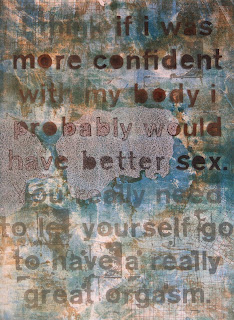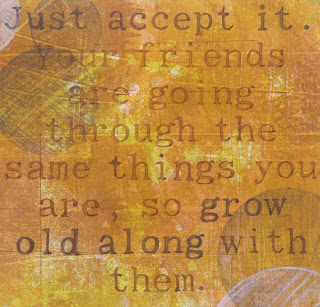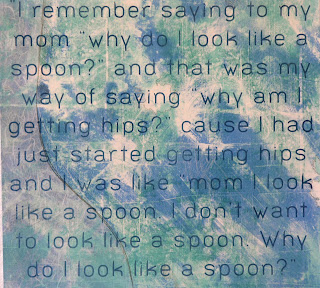I exist within two worlds; one that encompasses all of humanity, and the other that only accounts for half of it. I exist in the world of humankind; I feel the struggle and joy of life that comes with being alive. I understand injustice. I seek intelligence, I appreciate beauty, and I strive for success; I am one of many humans on this planet, all trying their best to survive. In addition, however, I exist within the world of womankind. I am female. I am a nurturer. I have breasts and hips, I have the ability to bear children, I understand the world in a way only other women would understand. I face struggles and issues that men do not.
When my partner in this collaboration sought women in order to create the backbone of this project, a series of monologues based upon women and their body image, she did a fantastic job of finding women who represented the breadth of this half of humanity. The women who participated in this project range in age from 21 to 81 years, vary in race and background, socioeconomic status, sexuality and personal history. Only two of the women actually knew each other, and neither of them knew they were both being interviewed for this project. Each woman volunteered their story, and provided insight of their own to help illustrate the world of “womankind.”
Each woman’s story was unique. Each story offered insight into the biography of the individual; they shared their joys and pains, charming anecdotes that wind in and out of conversation that provide understanding of the personalities and sensibilities of each woman. They spoke of issues of weight, issues of passing, issues of sexuality. They offered their stories and in doing so, it became evident that all women, regardless of their differences, face the same struggles. We all feel fat at some point. We all go through times where we harbor some sort of negative feelings towards ourselves at for one reason or another. We all have to pass the standards of society on some level. It is these things, not the fact we have ovaries and lack the “Y” Chromosome, these shared fights and experiences that make us women. We all struggle, that is a fact of humanity; but we struggle in a way that makes us truly female in every sense of the world.
I strived to create prints that presented text from each of the monologues and transcripts in an atmospheric representation of each woman. After reading the transcripts of each interview, I worked instinctually in order to create multilayered lithographs based upon my reaction to each reading; I picked colors that I felt could begin to represent their stories. Through these lithographs, I aimed to create a body of work that addressed the issues of being female; I hoped to represent each woman in a way that presented their personality and beauty.
In addition to the works on paper, I printed each image simultaneously onto silk habutai; these prints were then sewn into a quilt as a culmination of the project. I believe that art historically, a quilt is inherently “feminine.” It relates directly to the history of craft, to ideas of Gee’s Bend, War Wives, early settlers; whichever aspect of history you relate it to, quilts were made by women as a subtle art form. Women throughout history have taken pieces of whatever scraps they had in order to assemble something beautiful that held comfort for themselves and their family. I took my “pieces,” these bits of experience and history and sewed them into one. I united the pieces not only to make something beautiful, but to remind the quilt’s viewer that we as women are all the same and we should be offered a sense of unity and comfort from that fact. We may be very different, but underneath, we have intrinsic qualities that link us. We all have pieces, experiences, but it is those common experiences, those shared bonds no matter how small, that make us women. It is what defines us. It is what makes us one.
These prints are entitled "Woman/Women, Womon/Womyn," and are based upon the transcripts and monologue series, "My Body, My Voice," by Theresa Herring.

No. 1: "I think if I was more confident with my body, I probably would have better sex. You really need to let yourself go to have a really good orgasm.
(7 color lithograph with chine colle, conte, graphite.)
No. 2: "The first time I realized I was getting older was when I saw a picture of myself that a friend took of me down at the beach. That's when I realized that my breasts were sagging. I thought, "Oh, isn't that interesting," I never noticed it in the mirror but it did show up in the photograph. I was about 60, I guess, maybe a little older. But it didn't bother me."
(6 color lithograph with chine colle, ink.)

No. 2: "Just accept it. Your friends are going through the same things you are, so grow old along with them."
(6 color lithograph with conte, graphite, ink.)
No. 3: "My breasts, my body as a symbol of my sexuality and desirability, was really important."
(8 color lithograph)
No. 3: "BOOM! Breast cancer and chemotherapy knocked me out, pushed me into menopause, and while it probably wouldn't have been very practical for me to have children at such a late age, it was really sad to realize that I did
n't have a choice now. It was really all over."
(8 Color Lithograph)
No. 4: "I always felt like I was a failure because my mom was tall and thin and I was tall and big. I can remember one remark that really hurt me and still sticks with me today. She said that I was always going to be tall so I could be either a giraffe or an elephant. That was my choice."
(8 color lithograph, graphite, transfer paper)
No. 5: "I go into the weight room and I'm doing clings or jerks or three weight squats, these things that are not what girls in gyms are supposed to do."
(6 color lithograph, graphite, transfer paper)
No. 5: "How the hell can I go around saying, 'oh, I'm not going to play rugby because my shoulders will be broader and then I won't pass as well.' Because, in reality, is it any worse than someone telling my female cousin that she looks like a dyke? It really isn't different at all and thats the thing I've come to realize. The only difference in body issues between a trans person and non-trans person is how far on the passing scale you go."
(6 color lithograph, chine colle, conte, transfer paper, graphite.)
No. 5: "This is my body, not your body. Your body, you're giving to other people because you're not on the treadmill for yourself. You're on that treadmill for someone else and how dare you be threatened by the fact I am not on the treadmill for someone else."
(6 color lithograph, conte, graphite.)
No. 6: "So I've had a love-hate relationship with my body. Mostly loving it, mostly loving it. Sometimes hating it."
(8 Color Lithograph)
No. 6: "How would I describe myself to someone who has never seen me? I would say, 'My body is like a yam,' and they would be like, 'What? A yam?' and I would say, 'Yes, a yam because its not perfectly smooth, its certainly not skinny but its not round like a potato. Its got a few knots here and there, a few hairs hanging out places they probably shouldn't but by and large it's sweet when you cook it. Holla! Put a little sugar on it, make it all better!' I've literally described myself as a yam. Some people are string beans, I'm a yam. Not a potato, a yam. And they get it, they get it."
(8 color lithograph)

No. 7: "I remember saying to my mom, "why do I look like a spoon?" and that was my way of saying "why am I getting hips?" cause I had just started getting hips and I was like, "Mom, I look like a spoon. I don't want to look like a spoon. Why do I look like a spoon?"
(5 Color lithograph, chine colle, graphite, transfer paper)
 No. 7: "I started seeing my body as a really powerful vessel, started seeing my body as something that could carry me through life."
No. 7: "I started seeing my body as a really powerful vessel, started seeing my body as something that could carry me through life."(5 color lithograph, chine colle, graphite, transfer paper)

No. 7: "I think that a womon can use her body however she wants to se it. And I think that is very powerful for both her and everyone else. Having a womon's body means that I can do a lot of things that a man can't do, like hold a baby for 9 months and give birth and I think that is incredibly powerful. And empowering. Like it can be very empowering."
(5 color lithograph, chine colle, graphite, transfer paper)
No. 8: "Forget about looking like, you know, 'whatever the hot singer is of today.' It's about, 'you know what, I want to be a hip old lady.' I want to be that cool lady that can still drive herself and take herself to the movies. That's who I want to be. And that's about strength.
(4 color lithograph with chine colle, conte, graphite)
No. 9: "Just be good to your body. And your body will be good to you. And know your body the best as you can. One of my good friends had breast cancer last year and that made me realize that your body is something that you need to know."
(6 color lithograph)
No. 9: I'm content with my body. Not the happiest, but I don't hate my body. Like there have been things here and there, in different stages in my life, that I feel like "oh that could be better" but I don't lose sleep over it.
(6 color lithograph)
"Woman/Women, Womon/Womyn" Quilt
Lithograph on silk
Hope you enjoy.
Love,
Kylie
No comments:
Post a Comment